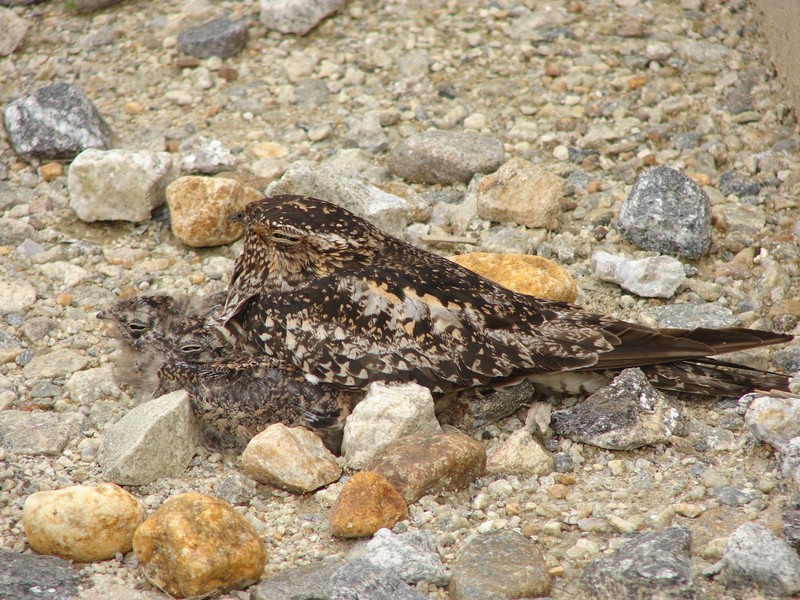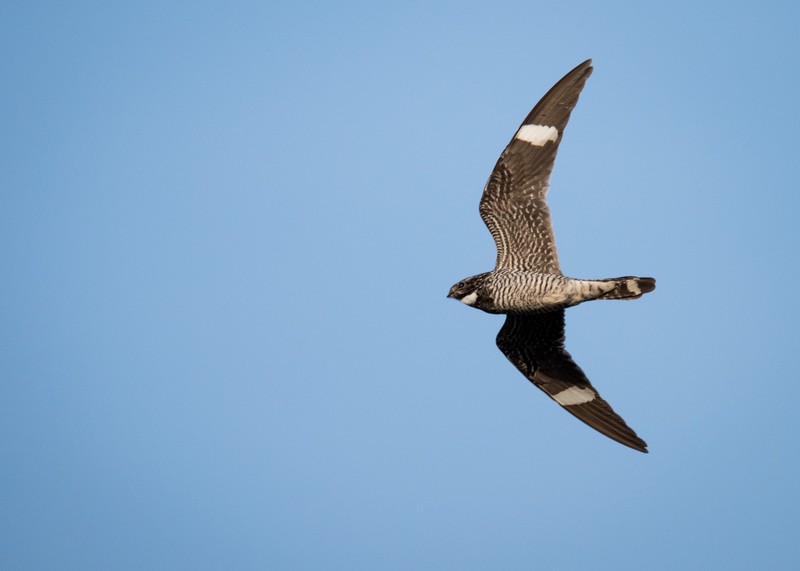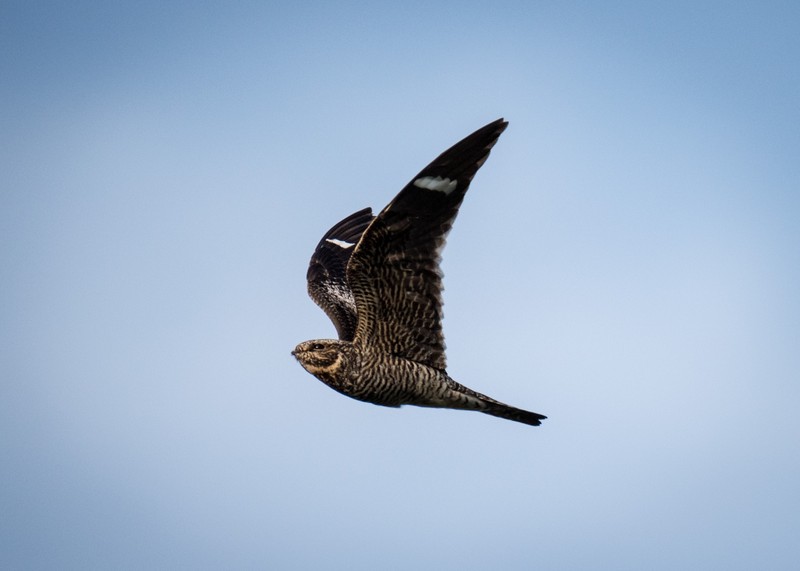Common Nighthawk
Chordeiles minor (Forster, 1771)
- Class
- Aves (Birds)
- Family
- Caprimulgidae (Nighthawks, Nightjars, and Goatsuckers)
- State Protection
- Special Concern
Listed as Special Concern by New York State: at risk of becoming Threatened; not listed as Endangered or Threatened, but concern exists for its continued welfare in New York; NYS DEC may promulgate regulations as to the taking, importation, transportation, or possession as it deems necessary.
- Federal Protection
- Not Listed
- State Conservation Status Rank
- S2S3B
Imperiled or Vulnerable in New York - Very vulnerable, or vulnerable, to disappearing from New York, due to rarity or other factors; typically 6 to 80 populations or locations in New York, few individuals, restricted range, few remaining acres (or miles of stream), and/or recent and widespread declines. More information is needed to assign either S2 or S3. (A migratory animal which occurs in New York only during the breeding season.)
- Global Conservation Status Rank
- G5
Secure globally - Common in the world; widespread and abundant (but may be rare in some parts of its range).
Summary
Did you know?
This species is neither active at night or a hawk as the common name implies.
State Ranking Justification
New York's Common Nighthawk population has a wide distribution, but low breeding population numbers throughout the state in urban and early successional habitats. The statewide breeding population has declined, with the most severe declines noted in western New York. Its natural habitat is under threat in New York principally from habitat loss and a decrease in prey. It has been noted that many other bird species occupying early successional habitats are experiencing range contractions (McGowan and Corwin 2008).
Short-term Trends
There was a 71% decline in occupied blocks from the first to the second Breeding Bird Atlas (Medler 2008). Medler (2008) also noted that the decline may be greater because 20% of reported observations were from the month of May when the species is still migrating to their nesting territories. During this time period, there were no confirmed breeding records from urban areas and only a few probable breeding records from New York City, Binghamton, and Buffalo. It appears that the species disappeared from the cities of Albany, Syracuse, and Rochester. There are some breeding populations in upstate New York that appear to be somewhat stable.
Long-term Trends
In the mid-1800s, Common Nighthawk began nesting on rooftops in the Northeast (Gross 1940 cited in Andrle and Carroll 1988). Soon after, the population appeared to increase. Declines were noted in several regions of the state by mid-1900s (Andrle and Carroll 1988). Bull (1974) noted that the species was formerly common and widespread, but its numbers had declined markedly. The first Breeding Bird Atlas in New York State (1980-1985) recorded Common Nighthawk throughout the state, but most observations were from cities and towns (Andrle and Carroll 1988). Levine (1998) described this species as a widespread but local breeder. While it has been acknowledged that Breeding Bird Surveys are not well-suited for crespular species, such as Common Nighthawk, the species has essentially disappeared from the New York routes by the 1980s (Sauer et al. 2007).
Conservation and Management
Threats
There are several anthropogenic threats that appear to have a significant effect on Common Nighthawk populations. Because of this species' insectivorous diet and other life history patterns, pesticides or other environmental contaminants could pose serious threats. Loss of early-successional habitats, such as conversion of farmland to forests, fire suppression, and development, is ongoing and pervasive. This species has adapted to urban areas by nesting on gravel roofs. However, rooftops are increasingly rubberized. This appears to be less suitable for nesting Common Nighthawks, perhaps due to the birds not being camouflaged on a rubber roof, eggs may roll on a smooth surface, and a rubberized roof may be too hot on sunny days (Marzilli 1989 cited in Brigham et al. 2020). Depredation of eggs and chicks by gulls and crows may have a significant impact on Common Nighthawk populations, especially in urban areas. Weather pattern changes associated with climate change could be a threat to this species. Extreme heat or cold and excessive rain during the breeding season may lead to nest failure either due to exposure or a decrease in insect populations.
Conservation Strategies and Management Practices
Management strategies that maintain or create suitable habitat are needed to provide breeding and roosting habitat for Common Nighthawks in New York State. In urban areas, the placement of gravel pads in corners of rubberized rooftops may attract this species (Marzilla 1989 cited in Brigham et al. 2020). However, New Hampshire Fish and Game (2015) suggests that large, gravel rooftops are needed for the species. Consider offering incentives in urban areas for gravel roofs instead of rubberized roofs. Careful planning is needed in areas where development is encroaching on suitable habitat to reduce the impact on Common Nighthawks. This species has adapted to breeding in urban areas, but they require areas to roost and nest, as well as ample supply of insects. Management plans, especially near cities and towns, should consider depredation risk from raccoons, opossums, skunks, cats, dogs, and crows.
In natural habitats, management strategies may include forest thinning, periodic control burns, and shrubland maintenance. The best management strategy is to manage the natural community, or habitat, where this species occurs. Maintaining pine barrens with their full suite of plant and animal species requires frequent (every five to ten years) disturbance to maintain open-canopy, shrub-dominated communities and to prevent succession to a closed-canopy hardwood forest (Jordan et al. 2003). Researchers have determined that "an active fire management program utilizing prescribed fire with appropriate mechanical treatments" is the preferred method (Jordan et al. 2003). Researchers have also determined that the size, type, intensity, and timing of fires (pyrodiversity) needs to be evaluated for each site to maximize benefits to the natural community and the species it supports (Jordan et al. 2003). The entire occupied habitat for a population should not be burned in a single year. Forest thinning and clearcutting may be useful in some habitats, but further research is needed on the intensity and frequency. Another consideration is how insect populations are affected by management practices. Eliminate or reduce insecticide use, especially in occupied habitat. Encourage the use of Integrated Pest Management in agricultural settings. Agricultural practices that include hedgerows and shrubby areas will provide breeding, roosting, and foraging areas.
Research Needs
One of the most important areas in need of research is regarding conservation. Impacts of pesticide use on Common Nighthawk prey (insects) needs further investigation. Positive and negative effects of logging and control burns are needed, as well as identifying which practices are most beneficial for the breeding success of this species. In urban areas, additional studies are needed on how to provide suitable habitat for nesting birds, for example, the effectiveness of gravel pads on rubberized roofs. Additional research on nest site selection and productivity, roost site preferences, and effects of depredation should be explored.
Habitat
Habitat
Common Nighthawks are found in natural open habitats and urban areas. In its natural habitat, this species can be found foraging in open areas near wetlands or wooded areas. Eggs are laid on the ground without any nesting materials in open areas (Brigham et al. 2020. Breeding season habitats includes gravel bars, rock outcrops, forest clearings, open pine woods, coastal sand dunes, beaches, and sparsely vegetated grasslands. In urban areas, this species nests on gravel roofs. They can be observed early mornings and evenings foraging over cites during the breeding season and during migration.
Associated Ecological Communities
- Brushy cleared land*
A former forest, woodland, or shrubland that has been clearcut or cleared by brush-hog. The cut stumps of trees and shrubs are evident and usually common. There may be a lot of woody debris such as branches and slashings from trees that were logged. Vegetation is patchy, with scattered herbs, shrubs, and tree saplings.
- Cropland/field crops*
An agricultural field planted in field crops such as alfalfa, wheat, timothy, and oats. This community includes hayfields that are rotated to pasture.
- Dwarf pine plains
(guide)
A woodland community dominated by dwarf individuals of pitch pine and scrub oak that occurs on nearly level outwash sand and gravel plains in eastern Long Island. The soils are infertile, coarse textured sands that are excessively well-drained.
- Maritime dunes*
(guide)
A community dominated by grasses and low shrubs that occurs on active and stabilized dunes along the Atlantic coast. The composition and structure of the vegetation is variable depending on stability of the dunes, amounts of sand deposition and erosion, and distance from the ocean.
- Maritime shrubland*
(guide)
A shrubland community that occurs on dry seaside bluffs and headlands that are exposed to offshore winds and salt spray.
- Oak openings*
(guide)
A grass-savanna community that occurs on well-drained soils. In New York, these savannas originally occurred as openings within extensive oak-hickory forests. The best remnants occur on dolomite knobs.
- Pine barrens shrub swamp*
(guide)
A shrub-dominated wetland that occurs in shallow depressions in the coastal plain, often as the transition zone between a coastal plain pond shore and either pitch pine-scrub oak barrens or pitch pine-oak forest.
- Pitch pine-scrub oak barrens
(guide)
A shrub-savanna community that occurs on well-drained, sandy soils that have developed on sand dunes, glacial till, and outwash plains.
- Post oak-blackjack oak barrens
(guide)
Open barrens on upper slopes and low ridges characterized by the presence of stunted individuals of post oak, scarlet oak, and blackjack oak. There is a sparse heath and grass ground cover growing in very dry, deep, exposed sand overlying a clay subsoil.
- Successional old field*
A meadow dominated by forbs and grasses that occurs on sites that have been cleared and plowed (for farming or development), and then abandoned or only occasionally mowed.
- Urban structure exterior
The exterior surfaces of metal, wood, or concrete structures (such as commercial buildings, apartment buildings, houses, bridges) or any structural surface composed of inorganic materials (glass, plastics, etc.) in an urban or densely populated suburban area. These sites may be sparsely vegetated with lichens, mosses, and terrestrial algae; occasionally vascular plants may grow in cracks.
* probable association but not confirmed.
Associated Species
Range
New York State Distribution
Common Nighthawk is a local breeder statewide with some concentrations in urban areas. In the 1970s, this species was found in many urban settings, such as Albany, Buffalo, Rochester, and Syracuse (Bull 1974). During the second Breeding Bird Atlas, Common Nighthawks were only reported from New York City, Binghamton, and Buffalo (Medler 2008). There have been noted declines of breeding in more natural habitats. Concentrations are noted in the areas of the Fort Drum Military Reservation, eastern Clinton County, and eastern Long Island.
Global Distribution
Common Nighthawk nesting range extends from southern Yukon, southern Mackenzie, northern Saskatchewan, northern Manitoba, northern Ontario, central Quebec, southern Labrador, New Brunswick, Prince Edward Island, and Nova Scotia south virtually throughout North America to California, south-central Nevada, Arizona, southern Texas, Gulf Coast, and southern Florida in the United States; also Middle America from Sonora and Chihuahua, Mexico, south through central Guatemala to western Honduras, and along Atlantic slope locally from Tamaulipas through southern Veracruz, and in Belize, eastern Honduras, northern Nicaragua, Costa Rica, and Panama, and possibly in southeastern Colombia in South America (Poulin et al. 1996).
During the northern winter the range includes South America south to northern Argentina (Poulin et al. 1996).
In migration this species occurs throughout Middle America and the West Indies.
Identification Comments
Identifying Characteristics
This species is a medium-sized bird that is approximately 22-24 cm and has cryptic plumage of gray, black, white, and buff. There is pronounced barring on the abdomen and sides. The head has a flattened appearance, the eyes are large, and only the tip of the beak is usually visible. The neck is short. Wings are long, slender, and pointed with a white patch across the primaries, approximately 2/3 of the way to the tip. Both sexes have a notched tail. Males have a white band on the tail while most females do not. Males have a visible white, V-shaped throat patch. Females also have a throat patch, but it is typically a buff/white color that is indistinct. Juveniles are lighter in color than the adults. They often lack the throat patch, or it’s mottled, and the white tail band is absent (Brigham et al. 2020). Eggs are elliptical or almost elliptical. There is some variation in the color of the eggs with the color ranging from creamy white to olive-gray with heavy speckling of gray, brown, and black. Females almost always lay two eggs. This species does not construct a nest, rather it lays eggs on a bare surface such as unsheltered ground, gravel beaches, rocky outcrops, open forests, or gravel rooftops. Common Nighthawk has a distinctive, buzzy call that is similar to American Woodcock calls (“peent”). Their looping flight pattern can be observed in the mornings and evenings while they are foraging for insects.
Characters Most Useful for Identification
This species can be identified in flight by the long pointed wings with a white patch.
Best Life Stage for Proper Identification
Adults are easiest to identify especially in the evenings while they are foraging for insects.
Behavior
This species can be observed foraging over cities during migration and the breeding season especially in the early mornings (dawn) and evenings. Insects are scooped up while in flight as the bird opens it gaping mouth. They can be observed flying a loop pattern. Courtship flights by the male includes repeated calling while flying in circles and hovering high in the air. He goes into a steep dive that causes a booming sound as the air passes through the wing feathers. Then he lands near the female and displays (spreads his tail and rocks back and forth while calling).
Diet
Common Nighthawks exclusively eat insects, such as moths, queen ants, wasps, beetles, flies, mayflies, crickets, and grasshoppers.
Best Time to See
In New York, spring migrants are often observed April through May. Breeding has been reported from late-May through mid-August. Fall migration begins in August with peak numbers reported from late August to early September (Levine 1998). Birds are most often observed during fall migration. This species is rarely found before mid-May and after September.
- Active
- Reproducing
The time of year you would expect to find Common Nighthawk active and reproducing in New York.
Similar Species
- Chuck-will's-widow (Antrostomus carolinensis)
(guide)
Common Nighthawks can be distinguished from Chuck-will's-widow by the by lack of rictal bristles, white wing patches, different tail pattern, and long, unbarred, pointed wings.
- Whip-poor-will (Antrostomus vociferus)
(guide)
Common Nighthawks can be distinguished from Whip-poor-will by the by lack of rictal bristles, white wing patches, different tail pattern, and long, unbarred, pointed wings.
Common Nighthawk Images
Taxonomy
Common Nighthawk
Chordeiles minor (Forster, 1771)
- Kingdom Animalia
- Phylum Craniata
- Class Aves
(Birds)
- Order Caprimulgiformes
(Nightbirds)
- Family Caprimulgidae (Nighthawks, Nightjars, and Goatsuckers)
- Order Caprimulgiformes
(Nightbirds)
- Class Aves
(Birds)
- Phylum Craniata
Additional Resources
References
American Ornithologists' Union (AOU). 1983. Check-list of North American Birds, 6th edition. Allen Press, Inc., Lawrence, Kansas. 877 pp.
Andrle, Robert F. and Janet R. Carroll, editors. 1988. The atlas of breeding birds in New York State. Cornell University Press. 551 pp.
Brigham, R. M., J. Ng, R. G. Poulin, and S. D. Grindal. 2020. Common Nighthawk (Chordeiles minor), version 1.0. In Birds of the World (A. F. Poole, Editor). Cornell Lab of Ornithology, Ithaca, NY, USA. https://doi.org/10.2173/bow.comnig.01
Bull, John. 1974. Birds of New York State. Doubleday, Garden City, New York. 655 pp.
Cornell Lab of Ornithology. 2019. All About Birds: Common Nighthawk. Cornell Lab of Ornithology, Ithaca, New York. https://www.allaboutbirds.org/guide/Common_Nighthawk/overview Accessed on [June 23, 2021].
Dickerman, R. W. 1990. Geographic variation in the juvenal plumage of the common nighthawk (CHORDEILES MINOR) in North America. Auk 107:610-613.
Ehrlich, P. R., D. S. Dobkin, and D. Wheye. 1992. Birds in Jeopardy: the Imperiled and Extinct Birds of the United States and Canada, Including Hawaii and Puerto Rico. Stanford University Press, Stanford, California. 259 pp.
Gross, A. O. (1940). "Eastern Nighthawk." In Life histories of North American cuckoos, goatsuckers, hummingbirds, and their allies., edited by A. C. Bent, 206-234. U.S. Natl. Mus. Bull. 176.
Jordan, M. J., W. A. Patterson III, A. G. Windisch. 2003. Conceptual ecological models for the Long Island pitch pine barrens: implications for managing rare plant communities. Forest Ecology and Management 185, 151-168.
Levine, E. 1998. Bull's birds of New York State. Comstock Publishing Associates, Ithaca, NY.
Marzilli, V. (1989). Up on the roof. Maine Fish and Wildlife 31:25-29.
McGowan, K.J. and K. Corwin, eds. 2008. The Second Atlas of Breeding Birds in New York State: 2000-2005. Cornell University Press, Ithaca, NY. 688 pp.
Medler, Matthew D. 2008. Common Nighthawk (Chordeiles minor). In The second atlas of breeding birds in New York State (K.J. McGowan and K. Corwin, eds.). Cornell University Press, Ithaca, NY.
New Hampshire Fish and Game Department. 2015. New Hampshire wildlife action plan. Appendix A: Birds. 371 pp.
New York Natural Heritage Program. 2024. New York Natural Heritage Program Databases. Albany, NY.
Poulin, R. G., S. D. Grindel and R. M. Brigham. 1996. Common nighthawk; The Birds of North America. Vol. 6, No. 213. American Orinithologists' Union. The Academy of Natural Sciences of Philadelphia.
Sauer, J.R., J.E. Hines, and J. Fallon. 2007. The North American breeding bird survey, results and analysis 1966-2006. Version 10.13.2007. US Geological Survey, Patuxent Wildlife Research Center, Laurel, MD.
Terres, J. K. 1980. The Audubon Society encyclopedia of North American birds. Alfred A. Knopf, New York.
Links
About This Guide
This guide was authored by: Shaw, Hollie Y.
Information for this guide was last updated on: July 13, 2021
Please cite this page as:
New York Natural Heritage Program. 2024.
Online Conservation Guide for
Chordeiles minor.
Available from: https://guides.nynhp.org/common-nighthawk/.
Accessed July 27, 2024.


